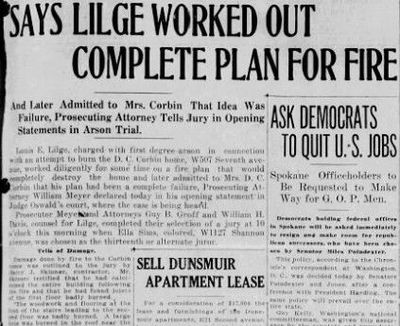This column reflects the opinion of the writer. Learn about the differences between a news story and an opinion column.
100 years ago in Spokane: The arson trial centered on the famous Corbin house was beginning

Prosecutors laid out the first-degree arson case against Louis E. Lilge, the caretaker of the landmark D.C. Corbin home.
“I will show you that the defendant, Lilge, had worked for some time on a fire plan that would completely destroy the Corbin residence,” the prosecutor said. “Mrs. D.C. Corbin will testify that after the fire, Lilge confessed to her that he had made a complete failure of the job.”
This indicated that Anna Corbin would, in fact, testify in the case, but that she would blame Lilge for the plan. Earlier, she had confessed that she and Lilge planned it together to collect the insurance money.
From the streetcar beat: City business leaders proposed a compromise they believed would defuse the transit crisis that was roiling the city.
The implementation of an 8-cent fare, up from 6 cents, had caused a rebellion of streetcar riders. Auto drivers were picking up passengers at streetcar stops and giving them rides as a way of protesting the 8-cent fare.
Business leaders suggested that the streetcar companies accept a fare increase to 7 cents, instead of the 8 cents granted by a state commission.
The city’s two streetcar companies maintained that an 8-cent fare was necessary to cover their costs. Business leaders, however, offered an incentive for the companies to accept the 7-cent compromise. Under the agreement, jitneys (private cars, vans and buses) would be banned.
The streetcar companies saw the jitneys as a threat to their existence. The Streetcar Men’s Union threatened to walk out if the city allowed jitneys to compete with streetcars.